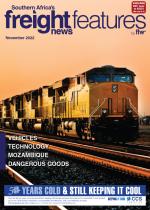Ca minhos de Ferro de Moçambique (CFM), the government-owned railway company of Mozambique, is upgrading 42 kilometres of the Ressano Garcia railway line to the tune of $66 million – while another $200m is set to be invested in the upgrade of the Machipanda line.According to Adélio Dias, CFM director of communication, this is in line with ongoing upgrades and investment aimed at increasing trade with South Africa and decreasing the number of trucks using the road through the Lebombo Border – as well as improving the rail transit between Mozambique and Zimbabwe.He said it was all part of a bigger road-to-rail strategy in the country. “The aim is to maximise the utilisation of the railway line. Ensuring our infrastructure can handle more volumes is critical.“The Machipanda line rehabilitation is a big project and it will be a state-of-the-art line once concluded and commissioned,” he said.Other ongoing projects include the rehabilitation of a bridge on the Goba line and the construction of a bridge near Salamanga. “This project is an investment of $6m,” said D ia s. “ We have recently concluded the construction of two bypass lines for the Dugong cement plant in Salamanga, an investment of $3.5m, and the terminal upgrade in Ressano Garcia, also $3.5m. We have invested a further $4.9m in a railway telecommunication system for the Ressano Garcia line. This system allows CFM improved control of trains on the line.”He said rehabilitation was an ongoing process at CFM. “We tend to focus on rehabilitation if and when it makes financial sense,” he said. “In terms of new lines, these are not off the table. We have constructed a new railway line between Mutarara and Vila Nova .”This $30m project saw a completely new railway line of 46km constructed and improves rail transit to Malawi from Mozambique.According to Dias, improving the interface in the Maputo port area to provide greater f lexibility in the rotation of rolling stock through the increase in reception and dispatch lines for trains is also a priority.“The acquisition of rolling stock, locomotives and wagons to meet the growing demand is important, and in this regard we continue to invest in strengthening and maintaining the infrastructure. We are also investing in road signage systems and working with customs to improve the customs clearance system through the integration of the rail management system to the electronic single window.”He said this included an agreement with Transnet Freight Rail (TFR) to introduce a system where trains no longer stop at the borders.“The aim is to ensure efficiency and reduce delays for cargo moving between the two countries as much as possible.”He says an example of major gains has been that of the Ressano Garcia terminal which now has a capacity of three MTPA. “This is a very innovative project in the country, delivering a combination road/rail solution aimed at reducing operational costs and the number of trucks in urban areas. We estimate a reduction of transport costs by as much as 16%."

